Anyone who has ever faced repairs or building their own home knows how important it is to make a flat floor. There are many technologies by which you can achieve a flat surface.
The main requirements for flooring are to provide heat and sound insulation, to be flat, not to deform or bend under the action of loads. Of course, aesthetic appeal also plays an important role. All this can be achieved with self-leveling floors.
Content
What kinds of floors are there?
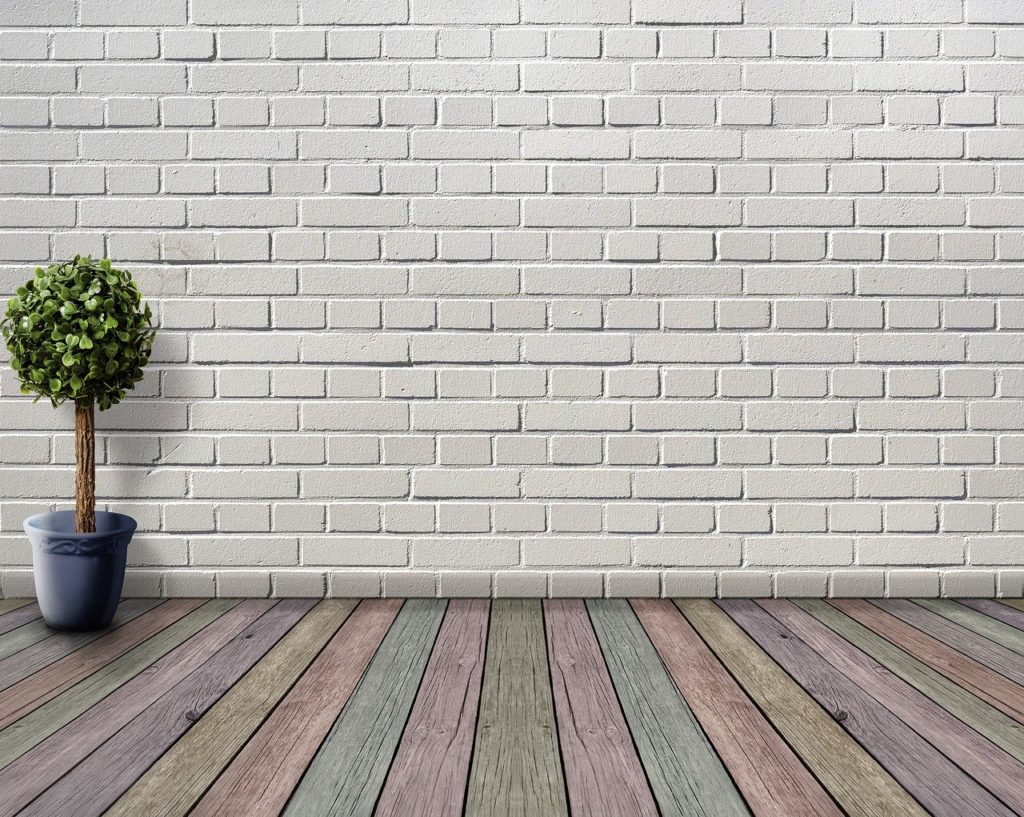
Depending on where the flooring is to be laid, the floors are divided into three main types:
Warm
A classic and long-used option. It is used in individual houses and on the first floors of buildings, where it is important to prevent freezing of the surface and preserve heat.
For its device, the base is pre-poured and waterproofed, then the base for the future flooring is constructed using a lathing of beams or logs. Boards or sheets of plywood are laid on the resulting structure. If boards are used for flooring, such a floor itself serves as a good decoration due to the beautiful texture of the wood.
Depending on the preferences of the owner, sometimes carpet or parquet is laid on top of the additional one.
In order not to introduce confusion, let us clarify the difference between a classic warm floor and a coating in which heating elements are installed in order to regulate its temperature and microclimate in the house. It is more correct to call this floor "active warm floor".
Such a floor is poured onto a pre-waterproofed and leveled concrete slab or a pre-made cement screed.
Cold
Cold, in turn, can be subdivided into two more classes:
- Dry
On the prepared base, loose material (expanded clay) is poured and tamped or foam plates are laid. Sheets of drywall are laid on top of them, and then the flooring is mounted (carpet, laminate, tile).
- Wet
A special building mixture is poured onto the cement screed - a self-leveling floor. The mixtures are prepared on site from a dry composition or supplied ready-made in special containers. On the spot, the self-leveling floor is poured onto the prepared surface, and, being a liquid by its properties, it spreads evenly over the base, forming a flat surface.
We will dwell on self-leveling floors in more detail in this review. This technology is steadily gaining popularity in the decoration of apartments, offices, industrial and commercial premises. A huge selection of design solutions, textures and colors make it possible to bring to life almost any design fantasy, and their performance allows them to be used in any room, under any temperature or humidity conditions.
In order to choose the right type of self-leveling floor, it is necessary to analyze the following indicators of the premises:
- Passability.If there is a large flow of people in the room, wear-resistant grades should be chosen.
- Humidity. It is not recommended to fill floors in excessively damp rooms containing gypsum, which is highly hygroscopic.
- Finishing. Is it planned to cover the finished floor with any coverings, or it will remain in plain sight.
What are the self-leveling floors?
By appointment
Draft
Used for leveling the surface with subsequent laying of floor coverings. This can be laminate, parquet, carpet or tile. Such self-leveling floors contain cement and polymer additives that improve the viscosity and fluidity of the mixture.
There are budget brands made from a sand-cement mixture. With this type of use, the screed will have to be leveled manually until a uniform and even surface is obtained.
Finishing
Also called "finishing". All types of self-leveling floors, regardless of composition, which do not imply subsequent laying on top of the coatings.
By composition

Cement
Consist of cement with additives (sand, plasticizers, dyes).
They allow you to hide slab defects, chips or cracks, as well as level the height difference. Cement mixtures can be poured in a layer up to 5 centimeters thick.
During the production of work, it is important to monitor the rate of supply of the solution so that air bubbles do not form in the thickness of the floor, which, when dry, form shells or bulges.
To eliminate such defects during operation, you can use a special needle roller. The needles, rolling over the surface of the solution, collapse the air bubbles, the voids from them are filled, the surface is leveled. Please note that this can be done only while the mixture has not yet begun to harden, otherwise the surface will be damaged and will require additional sanding and putty.
Working with this type of floor is not difficult. The solution dries long enough to do everything without haste and eliminate minor imperfections.
After pouring, it is recommended to cover the cement floor with polyethylene, having previously moistened with water, or moistened with a spray bottle. Thus, the concrete will gain strength.
Time to complete hardening takes from 4 to 12 hours. You can then walk on the floor. However, it fully acquires its strength characteristics in 14-30 days. Up to this point, it is not recommended to lay floor coverings and arrange furniture.
Gypsum
They are similar in purpose to cement. The composition contains gypsum and additives that improve strength and ductility. Not intended for use in wet areas. They have less strength than cement mixtures, which, however, is quite enough for use in residential premises.
Environmentally friendly, easy to use.
Both of the above varieties involve subsequent finishing, or application over another thin layer of the finishing floor.
Polyurethane
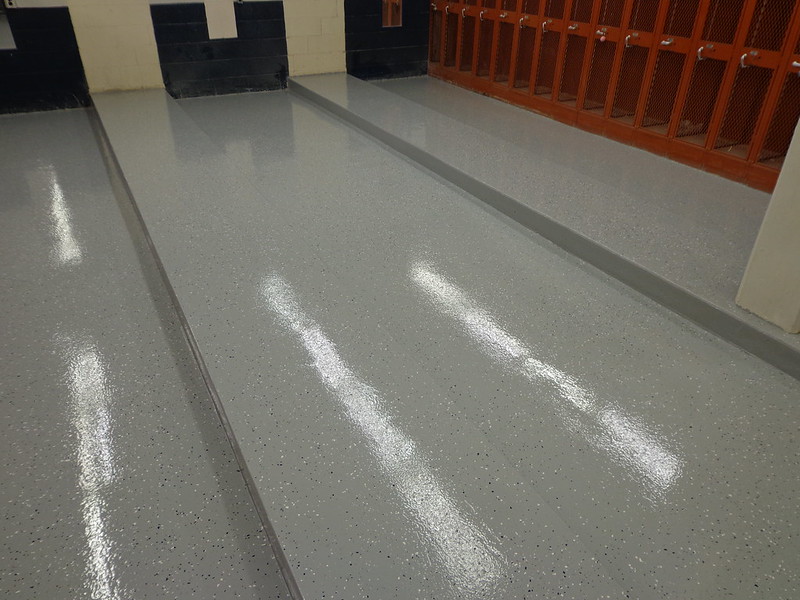
Two-component formulations containing resin and hardener and additives to improve performance and appearance. These can be dyes, PVC chips, or decorative chips (paint particles of different colors) to create a pattern in the thickness of the coating, or to imitate natural materials.
Depending on the purpose, polyurethane floors can have different elasticity, and are divided into elastic, universal, and rigid.
- Elastic brands are used in sports facilities, childcare facilities. The resulting surfaces are durable, vibration-resistant, and do not crack or fade.
- Rigid brands are suitable for industrial and office premises, hospitals, private houses and apartments.
Polyurethane floors are finishing. A layer up to 5 mm thick is applied to the pre-primed concrete screed, spreading evenly over the surface and not requiring additional processing.
Such surfaces are resistant to mechanical stress, environmentally friendly, and antistatic, which reduces the accumulation of dust on the surface.
Epoxy
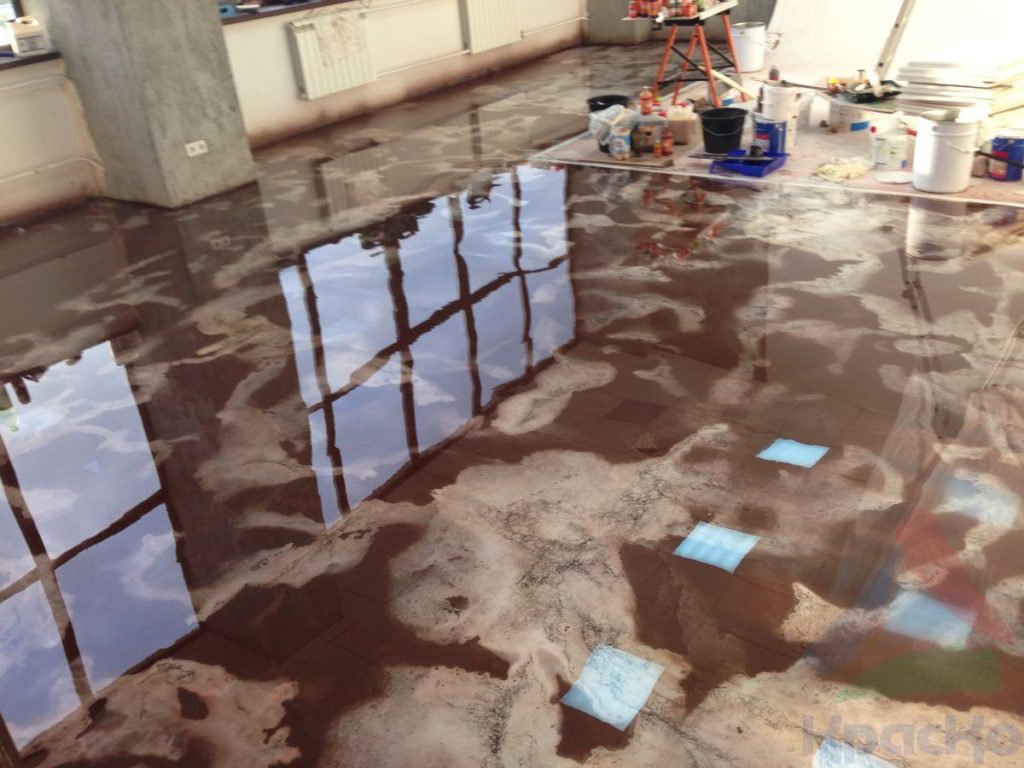
Two-component formulations of epoxy resin and hardener.Can be painted at the request of the customer in any color. The surface of the self-leveling floor, made using this technology, will be distinguished by perfect evenness. Depending on the composition, the texture of the self-leveling floor can be glossy or matte. Certain brands can be used as a filler of quartz sand or decorative chips, to reduce the consumption of the mixture and give it additional strength and decorative characteristics.
Epoxy self-leveling floors are supplied in containers as two components. These components are mixed in proportions strictly defined by the manufacturer, otherwise there may be a marriage or the possibility that the surface does not completely polymerize. The resulting composition has a limited lifespan, so the professionalism of the stackers and the speed of work are crucial.
Epoxy self-leveling floors provide a huge potential for creativity. A pattern or drawing can be applied to the base. When solidified, the resin will create a three-dimensional impression. Also, the base is often decorated with some small objects, it can be river pebbles, shells, coins that look original in the interior. Also, the finished surface can be given the appearance of natural stone, marble, mosaic, wood.
A common technique is the zoning of premises by color, when its individual parts are filled with different colors, while the surface remains monolithic, without any joints.
The disadvantages of such floors include their increased vulnerability to shock loads, a heavy object that has fallen can lead to chips or dents.
Another disadvantage is the complexity of installation, especially in the case of decorative coatings.
Methyl methacarylate
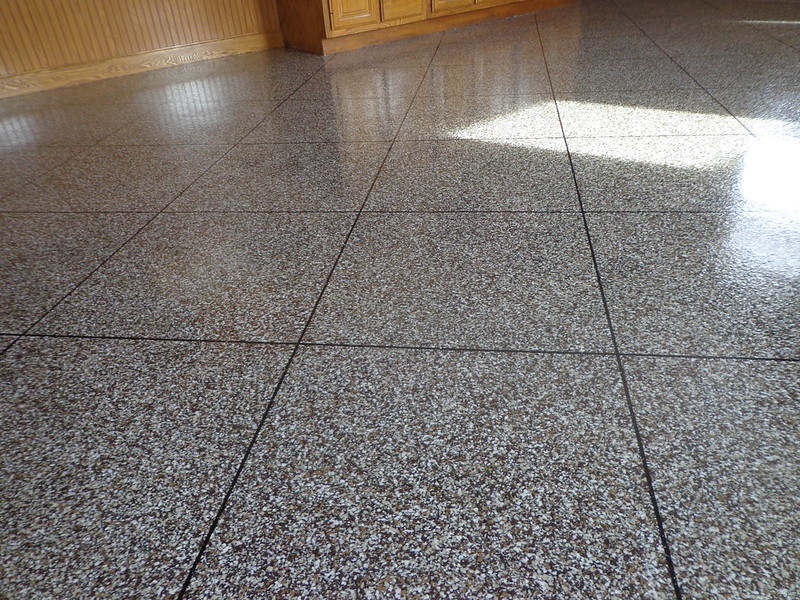
They consist of complex polymeric resins - methacrylate and acrylic. Strength characteristics are not inferior to concrete, resistant to ultraviolet light, do not fade, resistant to mechanical stress.
The surface obtained as a result of pouring does not need additional processing, grinding or painting - you can order the required color yourself.
Methyl methacarylate floors can be poured at subzero temperatures, which creates a wide field for their application outdoors, in unheated rooms, warehouses.
For apartments and private houses, this type of self-leveling coatings is rarely used.
The composition quickly hardens, which is both an advantage and a disadvantage of this type of coating. A short solidification time speeds up the work process, but at the same time requires high professionalism from the workers - a hitch in work can lead to the appearance of irregularities, cavities, or other defects. Due to the specific smell during work, careful ventilation is required.
Recommendations when working with self-leveling floors

Carefully prepare the base, level it, get rid of debris, dust.
Moisten or prime it as required by the instruction manual.
Use the appropriate type of self-leveling floor for the type of room.
If necessary, consult with specialists.
Carefully read the manufacturer's instructions, observe the proportions when preparing two-component formulations, remember the lifetime of the mixture in order to avoid rejects.
Observe safety precautions when working with methyl methacarylate mixtures. Protect respiratory organs and hands.
When choosing a drawing for 3D, think carefully about your choice. Don't get carried away with overly bright colors or exotic motives. The surface of the floor will serve you for decades, and it will be very disappointing if a recklessly chosen pattern bores you in a couple of years or becomes annoying.
The best manufacturers of self-leveling floors for 2020
The review includes:
QTR
Russian company specializing in the production of polymer mixtures, polyurethane and epoxy self-leveling floors, paints and varnishes, primers and related materials. The assortment includes more than 50 brands of self-leveling coatings for various purposes and properties. The company's specialists have developed thorough and comprehensive instructions that make it easier for inexperienced beginners to perform work.
Advantages:
- A wide range of;
- Manufacturing is located in Russia, logistics costs are reduced;
Disadvantages:
- High price for epoxy mixtures.
KNAUF
Knauf's products need no special introduction. This name is heard by anyone who has ever come across renovation or decoration. In addition to drywall, plaster mixes and related materials, the corporation also produces mixes for self-leveling floors.
Cement and gypsum mixtures for self-leveling floors are especially popular with buyers. Their price is slightly higher than Russian counterparts, but according to numerous consumer reviews, it is much easier to work with them than with budget counterparts - they are easier to prepare, fill irregularities with better quality and have a life span sufficient for comfortable work.
Advantages:
- Ease of work;
- High quality products.
Disadvantages:
- The price is higher than Russian analogues;
- A large number of fakes, be careful when choosing.
Epolastus
In third place in the ranking is a Russian manufacturer specializing in polymer mixtures. Two-component epoxy and polyurethane coatings of the Epolast brand are suitable for use in the decoration of apartments, country houses, industrial or office premises. A brand of epoxy floors with high decorative qualities and a large selection of colors and textures is perfect for arranging a self-leveling floor. There are also transparent mixes for creating 3D floors.
Advantages:
- High decorative properties;
- Wide range of colors;
- Ease of mixing.
Disadvantages:
- Not identified.
Teping
The second line of the review is occupied by another manufacturer specializing in self-leveling epoxy coatings. After pouring, the resin forms a smooth, glossy surface with good decorative qualities. The floor includes a base and a hardener, supplied in different containers for later mixing. If necessary, the mixture can be tinted to obtain the desired shade. The technology allows adding quartz sand to the ready-made mixture to create filled coatings and decorative chips to imitate natural stone.
Advantages:
- Excellent decorative properties;
- Wide range of colors;
- Ease of handling the finished mixture.
Disadvantages:
- Increased sensitivity to impact loads in finished floors.
Blockade
In the first place in the rating is a Russian manufacturer of building mixtures and paint coatings. Polyurethane self-leveling floors appeared in its range more than 5 years ago and quickly gained popularity among buyers due to the price / quality ratio and high performance characteristics. The company produces two-component mixtures of various degrees of hardness, from plastic ones used in gyms or children's rooms, to hard ones, suitable for use in apartments, houses or industrial premises.
Advantages:
- High strength and resistance to mechanical stress;
- Low price compared to epoxy grades.
Disadvantages:
- Low decorative properties.
Rating of the best self-leveling floors for 2020
Let's move on from manufacturers to specific brands.
Do not be confused by the fact that the buyer does not always choose the manufacturer that occupies the first lines of the rating. Not everyone makes an exclusive epoxy floor, or polyurethane, when renovating. The market continues to be dominated by cement and plaster solutions that allow for quick leveling of surfaces prior to laying topcoats.
The review includes:
| CERESIT CN83 | RUB 550 |
| Founding Roviline FK46 | 391 RUB |
| Plitonit UNIVERSAL | RUB 220 |
| Vetonit Weber fast 4000 | 320 RUB |
| KNAUF Tribon | 268 r |
| Vetonit Weber 4100 | RUB 470 |
| Volma Level Express | 229 r |
| Vetonit Weber 3000 | 534 RUB |
| Litokol CR300 | 295 RUB |
| Founding Skorline FK45R | 309 r |
CERESIT CN83

A universal cement mixture suitable for the production of works in residential and industrial premises, including unheated ones, and premises with high humidity.
Packaged in 25 kg bags.
The life of the prepared solution is 30 minutes.
Advantages:
- Versatility;
- High strength.
Disadvantages:
- High price in comparison with analogues;
- Short lifetime of the mixture.
Founding Roviline FK46
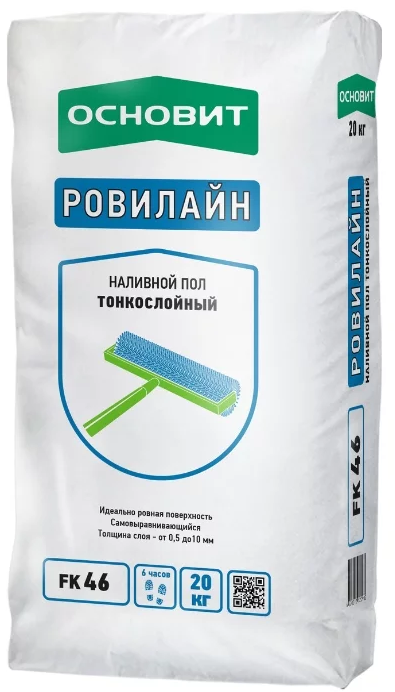
Finishing cement-sand mixture. Due to its use in the composition of sand, it is suitable for arranging a warm floor. It hardens quickly, has excellent adhesion to the substrate, excellent spreads.
It has one of the longest lifespan among cement self-leveling floors - up to 60 minutes.
Packaged in 20 kg bags.
The poured base can be walked on after 6 hours without subjecting it to additional stress. Full hardening time, depending on the thickness of the coating, is from 1 to 28 days.
The self-leveling floor is not intended for external work.
Advantages:
- Keeps working properties after cooking for 60 minutes;
- Excellent spreads;
- Does not crack.
Disadvantages:
- Not hardy.
Plitonit UNIVERSAL
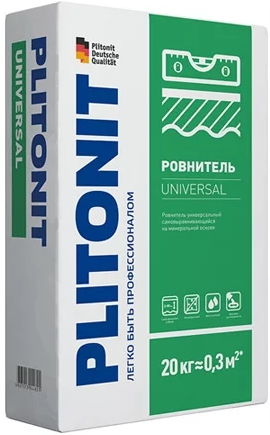
Cement-based universal self-leveling floor. Equally well suited for dry and damp environments. The brand refers to self-leveling and fast-hardening.
Suitable for creating a base for laminate, carpet or floor tiles.
The grain size, 0.63 mm, does not imply the use of a mixture without additional finishing work.
The mortar is viable for 30 minutes, the total drying time, depending on the layer thickness, is from 1 to 25 days, you can move on the poured floor after 7 hours.
Advantages:
- Suitable for underfloor heating;
- Universal for rooms with different humidity levels.
Disadvantages:
- Coarse grain size.
Vetonit Weber fast 4000
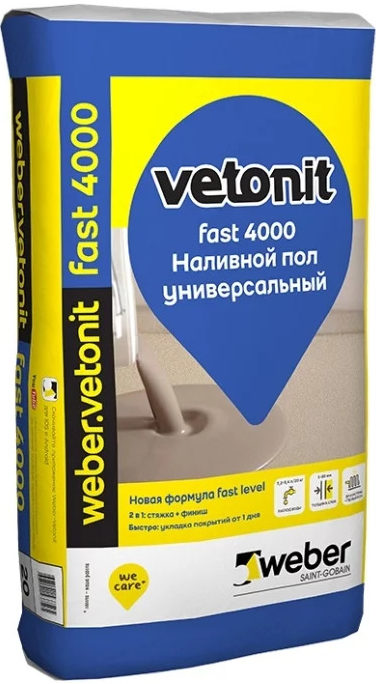
On the seventh place of the review is the basis for the preparation of a self-leveling floor from the manufacturer of the Vetonit brand. It contains cement with a grain size of 0.60 mm. The use of cement makes the mixture versatile for use in conditions of varying humidity - it is equally well suited as a base for laying tiles and laminate.
The permissible layer thickness varies from 5 to 80 mm, foot traffic is possible 4 hours after pouring, the time for complete hardening is from 1 day to 21 days, depending on the thickness. The prepared solution is viable for 30 minutes.
Advantages:
- Good value for money;
- Fast hardening.
Disadvantages:
- Coarse grain;
- Not suitable for outdoor use.
KNAUF Tribon
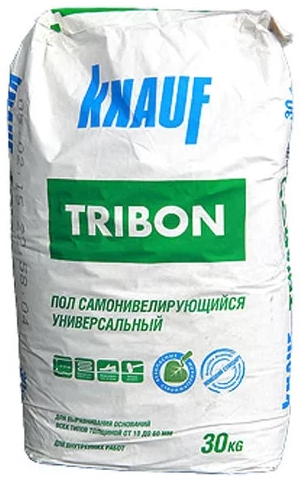
Cement-gypsum mixture for dry rooms. Has excellent fluidity. When solidified, it has increased strength. Perfect for laying active floor heating systems in it, or subsequent installation over a poured base.
The mixed mixture is viable for an hour. Walking time after 7 hours, complete curing, depending on the layer thickness, from 1 to 21 days.
Available in 30 kg bags.
Advantages:
- High strength of the finished floor;
- Good fluidity;
- Long mix life.
Disadvantages:
- Large packing weight - 30 kg.
Vetonit Weber 4100

The fifth place in the ranking is occupied by another model from Weber. It differs from the 4000 series by the use of plasticizers in the composition, which increase the hardness of the finished base, while simultaneously increasing the plasticity of the solution during operation.
The self-leveling floor is self-leveling and is suitable for dry and damp rooms, including underfloor heating. The recommended layer thickness is 2 to 3 mm.
The life of the mixture is 20 minutes, pay attention to this when starting work. Set to light foot traffic after 21 hours, fully dry 3 to 21 days.
Advantages:
- High strength;
- Profitability.
Disadvantages:
- Pot life of the finished mixture is 20 minutes.
Volma Level Express

Cement-sand self-leveling mixture for self-leveling floor, popular due to its low price. Suitable for pouring bases under all kinds of floor coverings, including underfloor heating. It does not have the best adhesion, so pay special attention to priming the surface before pouring. Also sensitive to pouring speed, which leads to bubbles and pits. Viable for 60 minutes after preparation.
Drying time to foot load - 6 hours, to full load from 3 to 24 days.
Advantages:
- Low price;
- Ease of operation.
Disadvantages:
- Lower strength in comparison with analogues.
Vetonit Weber 3000
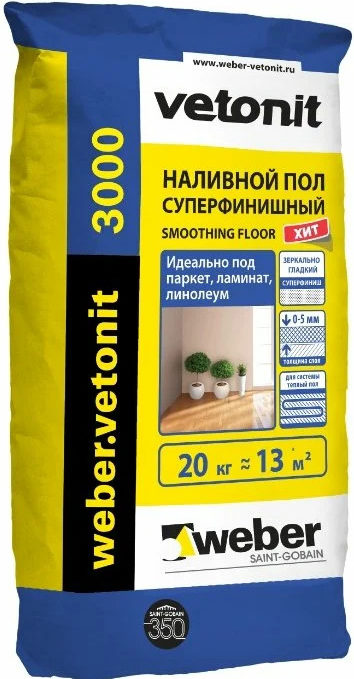
The next brand of self-leveling floor refers to superfinishing, after pouring it forms a smooth matte surface. Due to the thinness of the layer, a special requirement is imposed on the evenness and quality of the rough screed - it should not have height differences and cracks, otherwise there is a high probability of marriage. After pouring, it retains moisture resistance, which is especially valuable when working in damp rooms.
The ready-mix has a pot life of 30 minutes, foot traffic is possible 4 hours after application.
Advantages:
- Excellent leveling properties;
- Moisture resistance of the finished coating.
Disadvantages:
- High requirements for the quality of the base.
Litokol CR300
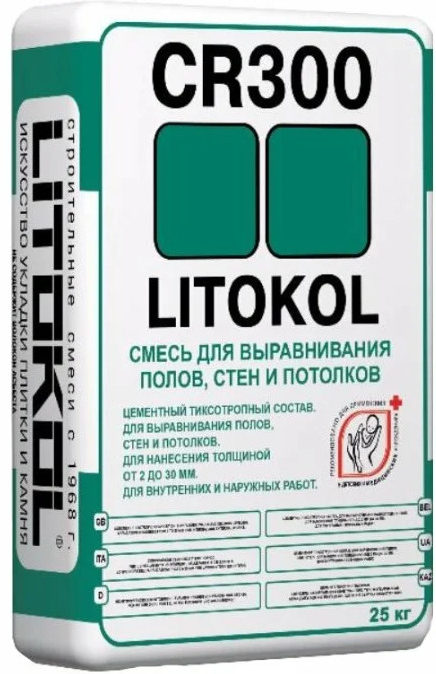
The second place in the rating is occupied by a universal frost-resistant mixture based on cement. The brand belongs to the finishing class, the recommended layer thickness is from 2 to 30 mm, the base should be well leveled and not have significant differences in height.
The cement base provides moisture resistance, and the plasticizers included in the self-leveling floor provide frost resistance and excellent fluidity of the finished solution.
Drying time for foot traffic - 7 hours. Complete drying - from 3 to 18 days.
Packing: 25 kg.
Advantages:
- Frost resistance;
- Versatility for dry and wet environments.
Disadvantages:
- Not identified.
Founding Skorline FK45 R

The first place in the rating for the cement-based universal self-leveling floor. The popularity of the brand is due to its low price and wide range of applications. It can be used in dry and damp rooms, it can be used both for leveling height differences, and as a finishing layer.
The life time of the finished composition is 40 minutes. Set to light foot traffic after 28 hours.
The time of complete hardening, depending on the thickness of the self-leveling floor, is from 2 to 28 days.
Advantages:
- Wide range of applications.
Disadvantages:
- Not identified.
If you have any experience in using self-leveling floors or tips, share them in the comments.












